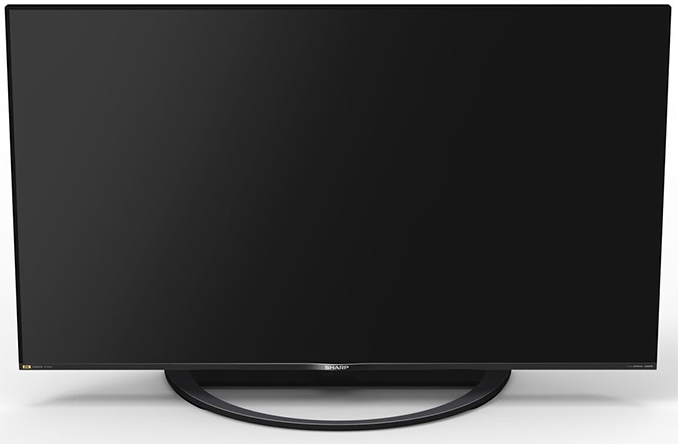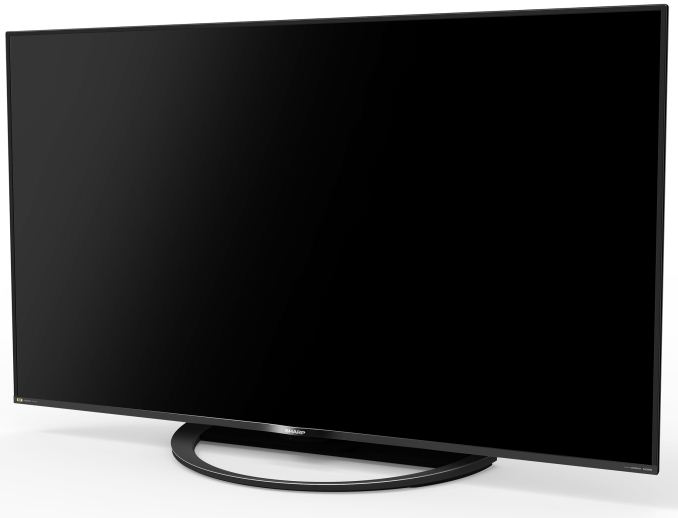Sharp Announces 2nd Gen 8K UHD TVs at IFA
by Anton Shilov on August 31, 2018 11:00 AM EST
Sharp this week introduced its second-generation 8K ultra-high def TVs at IFA in Berlin. The new televisions use the company’s new panels as well as the latest processors that can upscale Full-HD and Ultra-HD 4K content to a 7680×4320 resolution.
The initial lineup of Sharp’s 2nd Gen Aquos 8K UHD TVs will include models featuring sizes of 60, 70, and 80 inches. The new televisions will be based on the company’s new image processor that doubles its compute throughput over the predecessor and can upscale 2K as well as 4K content to an 8K resolution with a 100/120 Hz refresh rate.
The largest Aquos 8T C80AX1 80-inch flagship TV will rely on the company’s new UV2A II LCD (presumably IPS/IGZO) panel featuring a 100/120 Hz refresh rate, an “ultra-high brightness”, a “new wide color gamut”, and “high speed response”. The company does not quantify its claims, but it is logical to expect the new TV to be better than the existing Sharp Aquos LC-70X500E UHD TV that features a 400 nits typical brightness, a 1000 nits peak brightness for HDR (HDR10, HLG are supported), and an 8 ms GtG response time. Meanwhile, it is unclear whether a wider color gamut means a better coverage for the BT.2020 color gamut by a new 10-bit panel, or usage of a 12-bit panel.
Sharp plans to commercially launch its Aquos AX1-series 8K UHD TVs in Asia in late 2018 with European release sometimes in Q1 2019. The manufacturer said nothing about availability of its 2nd Gen 8K UHD TVs in the U.S., but since it calls the new family a “global 8K lineup”, it is logical to assume that the televisions will eventually be available in North America as well.
Related Reading:
- Sharp’s 8K UHD TV Available in Japan, Listed in Europe for €11,899
- CEATEC 2016: Sharp Showcases 27-inch 8K 120Hz IGZO Monitor with HDR, also 1000 PPI for VR
- Foxconn Takes Control of Sharp
Sources: Sharp, Technite-Video.de











49 Comments
View All Comments
Mitch89 - Monday, September 3, 2018 - link
That is such a hacky setup that nothing will support when 8K adoption genuinely starts.It's like the early 4K TVs that shipped with HDMI 1.4 so you couldn't display 4K at 50/60p.
Manch - Tuesday, September 4, 2018 - link
I get what you're saying but that's a horrible analogy. If you're able to run the engine to red line, then with that single gear you've already use the engine to its full advantage. Redline is rarely if ever the peak of an engines power band so you've actually ran past it. ;)JoeyJoJo123 - Friday, August 31, 2018 - link
It's really not. For people who like to play back older content, 640x480 fits into a 7680x4320 display in 12x magnification, with zero interpolation. Every resolution monitor up until 8k needs to interpolate probably the most common video resolution people own, the quintessential video standard of DVDs.I get what you're going to say next though:
>Are you really touting playback of DVD format video on 8k displays as a "feature"?!
In most respects, yeah, most people don't care, won't notice, but I do appreciate the option of having 8k as the one resolution where every smaller resolution can be scaled up to without interpolation. 8k is also basically the point where I think resolution wouldn't be appreciably better anymore, even to desktop users looking at a screen from 2 - 3 ft. I could tell the different in font rendering in 1080p -> 1440p -> 4k.
A distant dream now would be an Open Source Scan Converter (OSSC) that can take in any video game console (modern or old) and do an integer scale conversion of it up to 8k (with a powerful enough FPGA) in real time/no lag, and it'd work for upscaling popular content like the 480p consoles, like PS2, GCN, etc. Even if such a device existed now, without 8k as an option, you're not going to get a integer scale that fits the screen exactly for 480p on 4k. Likewise, with 8k and better contrast and better input lag TVs, you get even closer to not needing to have a PVM/BVM high-end CRT to get a retro look. While there are CRT-like filters, the problem is that even at 4k, the resolution isn't fine enough to properly imitate the CRT shadow mask. You can darken every 3rd line or so to imitate the scanline look, but the shadow mask is a really fine detail that can't really be emulated right now with 4k.
I would hope 8k would really be the last point of increasing resolution, since we'd be hitting a point where anything higher doesn't really matter, and more focus would be put on achieving better contrast, out-of-box calibration, off-axis color accuracy, input lag, display response times, etc.
austinsguitar - Friday, August 31, 2018 - link
do you realize how insanly difficult it is to produce an image in 8k. even upscaled video will be a pain to run quietly because of the gpu noise. i understand what you mean by older games thats really great... but. unless we are talkin quality its unimportant. upscaling old consoles on your 8k tv... really man?Kamus - Friday, August 31, 2018 - link
"even upscaled video will be a pain to run quietly because of the gpu noise."Sure... if you're using ancient hardware. My mom's notebook can play 8k video using only 5 watts (no videocard, just using the built intel graphics) and she bought that last year....
All it takes for 8k to "take off" is for Netflix, amazon, etc. to flip a switch and you're off to the races. The built in TV decoder should do the rest with no effort.
A lot of content is already recorded in 8k, and places like youtube have had 8k 60 with HDR video available for quite a while.
Now, as for the usability of 8k on a small living room... that's a different thing altogether. You probably wouldn't see any benefit unless it was a gigantic, curved screen that would envelop your whole FoV.
Used to be people whined a lot about the lack of 4k and HDR content... but all it took was for netflix and amazon to flip a switch, and now most of the new content is in both 4k and HDR. The same thing would be possible with 8k video with a 60 - 90 mbps bitrate.
CheapSushi - Friday, August 31, 2018 - link
These are probably the same people who said they couldn't tell the difference between 720p and 1080p and it was a total waste of money in every possible way. They're grumpy when others do something they wouldn't or can't afford.boeush - Friday, August 31, 2018 - link
"all it took was for netflix and amazon to flip a switch, and now most of the new content is in both 4k and HDR. The same thing would be possible with 8k video with a 60 - 90 mbps bitrate."Of course, then there's the pathetic reality that at least in the USA, with very few exceptions most people's "broadband" Internet runs at about 0.1x that raw bandwidth (without even taking any communications overhead, or sharing of bandwidth between different data streams, into account...) Maybe in more developed countries, streamed 8k content could be a viable option in the near term. But not in the pitifully backward U.S. "free market"...
cmdrdredd - Sunday, September 2, 2018 - link
This is misleading. You can't say "a lot of content is already recorded in 8k" without the caveat that digital intermediates are still very often finished at 2k. So the content is then scaled up from there. The source doesn't matter if the finished content below even 4k.,gfkBill - Sunday, September 2, 2018 - link
You can't even say (with a straight face) "a lot of content is already recorded in 8k", never mind caveats about DI's done at 2K or 1080 :Dcmdrdredd - Monday, September 3, 2018 - link
True, a lot of movies are filmed at resolutions below 4k and I'm surprised when a movie is filmed entirely at 6k. Though you have movies like Avengers Infinity War filmed entirely at 6.5k and formatted for IMAX then the movie is finished at 2k and scaled up. Like what the heck is that?